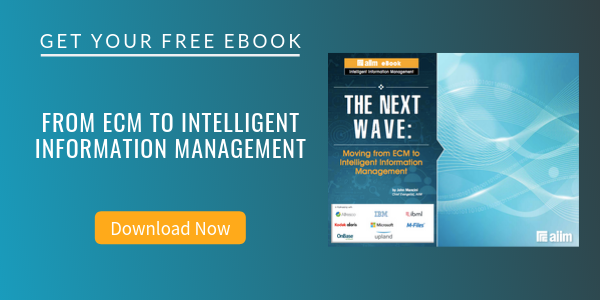
Content Management – Why Can’t We Stop Talking about Technology?
Enterprise Content Management (ECM) | Intelligent Information Management (IIM)
For many years, I’ve watched people in organizations that I KNOW could benefit from content technologies politely listen to sales presentations, nod their heads, and then back away from a decision.
I find this “reluctance to commit” mysterious because most of the people that I’ve spoken with who have automated a previously paper-driven process swear by the results and wouldn’t return to life pre-content management for anything.
I’m convinced that this “reluctance to commit” is due to the fact that many on the sell-side of our industry (including AIIM at times, I’ll confess!) can’t resist talking about technology. ECM! BPM! Taxonomies! Metadata! Capture!
But that’s not what content management is about anymore. It’s about how knowledge workers (who, BTW, are expensive!) are struggling with outdated and manual processes. It’s about customers who encounter broken processes, shake their heads, and turn away, never to return. It’s about organizations who thought they were “safe” and “established” increasingly turn around and find unexpected competitors coming out of nowhere.
So let’s forget about this “content management thing” for a moment and think about how bad, manual, and paper-clogged processes impact a few real people.
Do You Recognize these Five Faces of Information Chaos?
1. Matthew Hampton, Independent Insurance Agent
Matthew processes an application for a new boat policy using a template stored on his computer desktop. The problem is, he opens an old version of the policy. The application is rejected and the closing on the new boat is delayed. Now Matthew has to go back to a frustrated client who thought his application was in the underwriting process and start all over again.
2. Rick Reid, Mortgage Broker
Rick fails to notice that two time-critical items have not been received on a loan application for a young couple buying their new home. The couple is moving from their “starter” because they have a baby on the way. As a result of his oversight, the closing is delayed past the current rate lock, causing the couple to incur a higher interest rate. The seller gets a better offer on the house and decides to forgo the contract by enforcing the original close date. Due to process inefficiency, the Rick loses the loan and the young couple loses the home of their dreams.
Examples of process-related pain:
- Unproductive work hours
- Duplication of work
- Inadequate process controls
- Lack of instant access to records
3. Dr. Sonja Morgan, General Practitioner
Sonya is making the rounds of several rural offices that belong to her practice, carrying medical records for all the patients she is scheduled to see in the trunk of her car. Upon arriving at one of the clinics, she’s not able to find key updates on a few of the most seriously ill patients. Upon checking in with the practice, she also discovers that two emergency patients have come in, but their records are currently at another clinic. The acquisition and transfer of patient data from the other facilities results in critical time delays in patient treatment.
Examples of paper-related pain:
- High storage costs – both on-site and off- site
- Costs related to missing or damaged documents
- Manual processing inefficiencies
4. Ruth Curtis, Chief Financial Officer
Ruth worries whether her company’s outdated and manual accounts receivable handling has finally caught up with her. Customer service problems abound as relationships sour due to disputes and arguments about who owes what and when it is due. A core personal metric -- DSO (Days Sales Outstanding) -- has skyrocketed, threatening her credibility with the CEO and truth be told, the viability of the company itself.
5. Ronald Jones, Human Resources Director
Ron has always viewed his job as more talent scout than HR administrator, and has taken great pride in his organization’s ability to continue to hire great people, even as the organization rapidly expanded. He has worried about the casualness of company processes in face of rapid growth, and now that concern has come home to roost. A fired employee claims he was treated unfairly, Ron is going to be deposed in two weeks, and he knows employee files are in bad shape.
Conclusion
The challenges these people face are typical of the information chaos challenges facing people in every organization. And the sad thing for organizations who ignore these challenges is that they are becoming MORE complicated every day. They are becoming more complicated because of escalating growth in the volume and variety of information your organization must digest and the ever-increasing demands (and frustrations!) of your customers and constituents.
What are you going to do about it? When?
About John Mancini
John Mancini is the President of Content Results, LLC and the Past President of AIIM. He is a well-known author, speaker, and advisor on information management, digital transformation and intelligent automation. John is a frequent keynote speaker and author of more than 30 eBooks on a variety of topics. He can be found on Twitter, LinkedIn and Facebook as jmancini77. Recent keynote topics include: The Stairway to Digital Transformation Navigating Disruptive Waters — 4 Things You Need to Know to Build Your Digital Transformation Strategy Getting Ahead of the Digital Transformation Curve Viewing Information Management Through a New Lens Digital Disruption: 6 Strategies to Avoid Being “Blockbustered” Specialties: Keynote speaker and writer on AI, RPA, intelligent Information Management, Intelligent Automation and Digital Transformation. Consensus-building with Boards to create strategic focus, action, and accountability. Extensive public speaking and public relations work Conversant and experienced in major technology issues and trends. Expert on inbound and content marketing, particularly in an association environment and on the Hubspot platform. John is a Phi Beta Kappa graduate of the College of William and Mary, and holds an M.A. in Public Policy from the Woodrow Wilson School at Princeton University.



